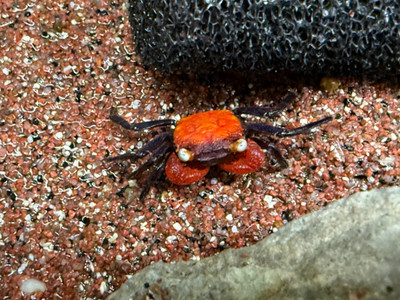Red Devil Crab
Posted by Max Gandara on on 7th May 2025
Meet the Red Devil Crab: A Fiery Jewel of the Terrarium World
When it comes to unique and eye-catching crustaceans, the Red Devil Crab (Geosesarma sp.) is a fiery standout. With its vivid red coloration, compact size, and semi-terrestrial lifestyle, this tiny crab has captivated the hearts of aquarists and terrarium enthusiasts around the world.
Origins and Habitat
Red Devil Crabs are a part of the Geosesarma genus, a group of small, colorful freshwater crabs native to Southeast Asia, particularly Indonesia and surrounding regions. These crabs are semi-terrestrial, meaning they split their time between land and water, typically living in humid, forested areas near streams and freshwater pools.
Appearance
The name "Red Devil" isn’t just for show. These crabs boast a striking bright red or crimson body with deep red claws and sometimes black accents. Their eyes stand out with a yellowish glow, giving them a slightly devilish look — hence the nickname.
Size-wise, they're relatively small, typically growing no larger than 2–3 cm (0.8–1.2 inches) across the carapace. But what they lack in size, they make up for in personality.
Behavior and Temperament
Red Devil Crabs are curious, active, and can be quite territorial, especially the males. They're mostly nocturnal but often seen scavenging for food during the day. In a terrarium setting, they’re known for climbing, burrowing, and interacting with their environment, making them fun to observe.
Though they're not aggressive toward humans, care should be taken when housing multiple crabs together — providing plenty of hiding spots and space can help reduce aggression.
Ideal Setup: Paludarium Paradise
Because Red Devil Crabs are semi-terrestrial, they thrive in a paludarium — a hybrid enclosure that includes both land and water elements. Here's what they need:
-
Humidity: 75–90%
-
Temperature: 22–28°C (72–82°F)
-
Water: Shallow, clean, dechlorinated freshwater
-
Substrate: Moist coco fiber, sphagnum moss, or soil for burrowing
-
Hiding Spots: Cork bark, caves, and live plants
-
Tank Size: A 10-gallon tank can house a small group, but more space is better
Make sure the enclosure is escape-proof — these crabs are excellent climbers!
Diet
Red Devil Crabs are omnivores. In the wild, they scavenge on detritus, plant material, and small insects. In captivity, a varied diet will keep them healthy:
-
Commercial crab pellets
-
Blanched vegetables (spinach, zucchini)
-
Bloodworms, brine shrimp
-
Fruit (occasionally)
-
Leaf litter
Feeding should be done every 1–2 days, and uneaten food should be removed to prevent mold or water contamination.
Breeding
Breeding Red Devil Crabs in captivity can be a challenge. Unlike some freshwater crabs, Geosesarma species carry their eggs until they hatch into fully formed juvenile crabs — no larval stage. Success depends on stable conditions, minimal stress, and a secure, well-structured habitat.
Final Thoughts
The Red Devil Crab may be small, but it adds a bold splash of color and life to any paludarium. With proper care, they can live for 2–3 years, offering endless fascination with their natural behaviors and vivid appearance. Whether you're a seasoned hobbyist or a beginner looking for a low-maintenance, exotic pet, the Red Devil Crab is a worthy addition to your collection.

